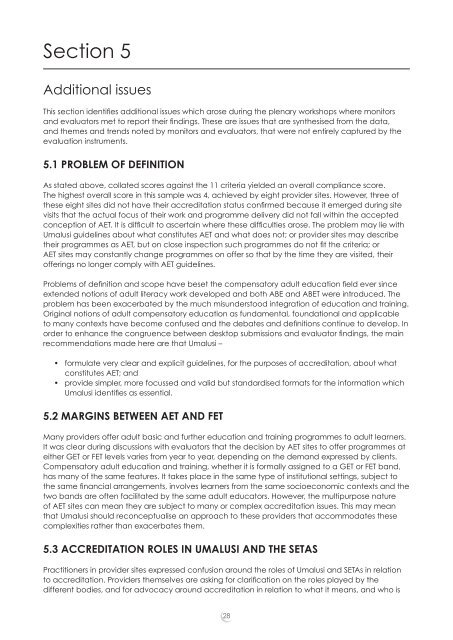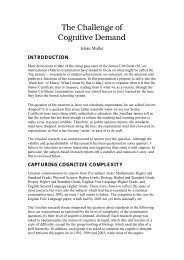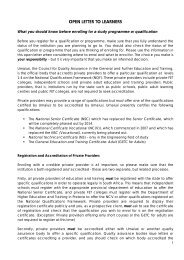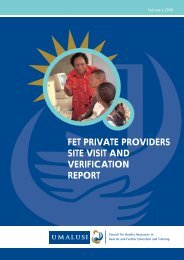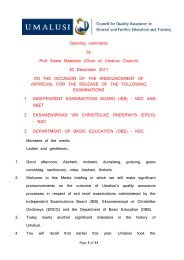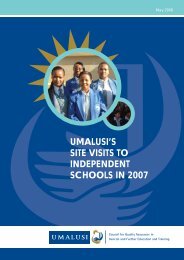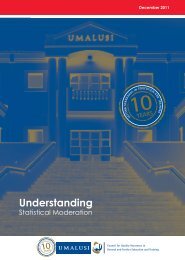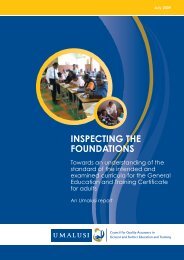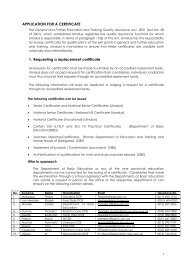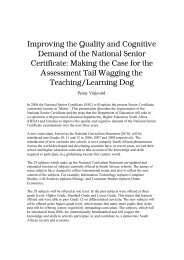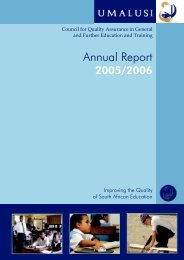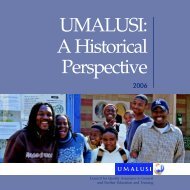Umalusi AET Report
Umalusi AET Report
Umalusi AET Report
- No tags were found...
Create successful ePaper yourself
Turn your PDF publications into a flip-book with our unique Google optimized e-Paper software.
Section 5Additional issuesThis section identifi es additional issues which arose during the plenary workshops where monitorsand evaluators met to report their fi ndings. These are issues that are synthesised from the data,and themes and trends noted by monitors and evaluators, that were not entirely captured by theevaluation instruments.5.1 PROBLEM OF DEFINITIONAs stated above, collated scores against the 11 criteria yielded an overall compliance score.The highest overall score in this sample was 4, achieved by eight provider sites. However, three ofthese eight sites did not have their accreditation status confi rmed because it emerged during sitevisits that the actual focus of their work and programme delivery did not fall within the acceptedconception of <strong>AET</strong>. It is diffi cult to ascertain where these diffi culties arose. The problem may lie with<strong>Umalusi</strong> guidelines about what constitutes <strong>AET</strong> and what does not; or provider sites may describetheir programmes as <strong>AET</strong>, but on close inspection such programmes do not fi t the criteria; or<strong>AET</strong> sites may constantly change programmes on offer so that by the time they are visited, theirofferings no longer comply with <strong>AET</strong> guidelines.Problems of defi nition and scope have beset the compensatory adult education fi eld ever sinceextended notions of adult literacy work developed and both ABE and ABET were introduced. Theproblem has been exacerbated by the much misunderstood integration of education and training.Original notions of adult compensatory education as fundamental, foundational and applicableto many contexts have become confused and the debates and defi nitions continue to develop. Inorder to enhance the congruence between desktop submissions and evaluator fi ndings, the mainrecommendations made here are that <strong>Umalusi</strong> –• formulate very clear and explicit guidelines, for the purposes of accreditation, about whatconstitutes <strong>AET</strong>; and• provide simpler, more focussed and valid but standardised formats for the information which<strong>Umalusi</strong> identifi es as essential.5.2 MARGINS BETWEEN <strong>AET</strong> AND FETMany providers offer adult basic and further education and training programmes to adult learners.It was clear during discussions with evaluators that the decision by <strong>AET</strong> sites to offer programmes ateither GET or FET levels varies from year to year, depending on the demand expressed by clients.Compensatory adult education and training, whether it is formally assigned to a GET or FET band,has many of the same features. It takes place in the same type of institutional settings, subject tothe same fi nancial arrangements, involves learners from the same socioeconomic contexts and thetwo bands are often facilitated by the same adult educators. However, the multipurpose natureof <strong>AET</strong> sites can mean they are subject to many or complex accreditation issues. This may meanthat <strong>Umalusi</strong> should reconceptualise an approach to these providers that accommodates thesecomplexities rather than exacerbates them.5.3 ACCREDITATION ROLES IN UMALUSI AND THE SETASPractitioners in provider sites expressed confusion around the roles of <strong>Umalusi</strong> and SETAs in relationto accreditation. Providers themselves are asking for clarifi cation on the roles played by thedifferent bodies, and for advocacy around accreditation in relation to what it means, and who is28


